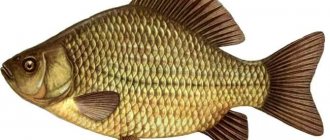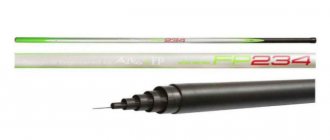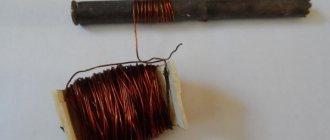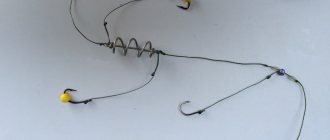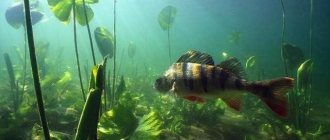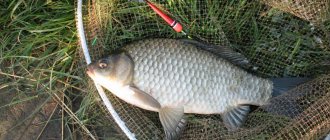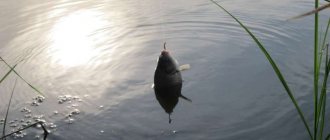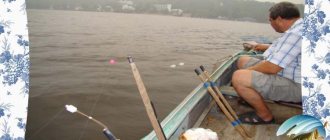What is a leash
Almost any fishing rod and tackle is equipped with a leash that connects the hook and the main line. Lineless equipment for catching crucian carp is almost never used. Depending on the type of tackle, there can be about five leashes (for example, “elastic”, “machine”, “nipple”), two or three (classic donka, feeder, etc.) or one or two (float rod).
Moreover, as an integral part of the equipment, they perform several functions at once:
- serve to make the tackle invisible to the fish;
- help preserve the float and sinkers in case of blind hooks or bites of a large specimen;
- allow the bait or lure to behave more naturally in the water.
Therefore, the correct design of leashes significantly affects the results of fishing. Too long or, conversely, short length can cause a lack of bite. The same applies to the thickness of the fishing line, which, due to its large cross-sectional diameter, often becomes too noticeable for crucian carp, scaring them away from the bait. And these are not all the nuances that any angler needs to know when installing and using leashes.
Depending on the gear, the number of leashes may vary
Leashes for crucian carp: monofilament or braided line
Crucian carp is a rather cautious fish, so the gear for catching it should be sensitive and light. This also applies to leashes, for which a fairly thin line is taken (even for donks no more than 0.2 mm). It can be either monofilament or braided. Moreover, each has its own pros and cons.
Monofilament line is best suited for leashes on float rods and feeders. The fact is that it is softer and has good shock-absorbing characteristics. What does this give to the fisherman? Firstly, the hook and bait itself, when entering the water, are more similar to the natural food of fish. Secondly, when biting a large fish or sharply hooking, a monofilament fishing line can soften the jerk and protect against breakage. In addition, if the rig gets caught on a branch or snag, then by pulling hard on the rig, you will only tear off the hook, which is faster and easier to replace than anything else.
Monofilament leashes also have disadvantages. One of these is as follows: such a fishing line quickly fails. Literally a few active fishing trips and the fishing line on the leash is better to be replaced. It just becomes too stretched, thinner and often begins to curl, interfering with successful catching of crucian carp.
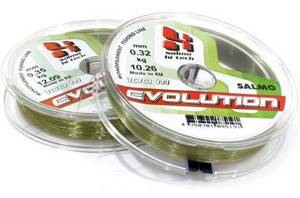
When fishing with a float rod for a leash, it is better to use monofilament fishing line
Braid is more suitable for leashes of bottom gear. And not only because of reliability and durability. The braided cord is more sensitive and practically does not stretch, so it is easier to notice a bite in tackle with such leashes. In addition, due to increased rigidity, the fish most often hooks itself - that’s why they like to use braided line on different types of bottoms. After all, when they are caught on them, it is quite difficult to make a hook in time.
The disadvantage of braided fishing line is its rigid structure and inextensibility. This can lead to breaks (especially with strong hooks) and fish escapes. Also, cautious crucian carp can easily notice a braided leash, especially if fishing takes place at shallow depths. It is also important to note that braided cord is more expensive than monofilament line. Indeed, for some fishermen, the issue of price is not the least important.
What kind of fishing line to make leashes for catching crucian carp from is up to the fishing enthusiast himself. Some people assume that you only need to focus on the length of the leashes. If they are short, then preference is given to wicker. If more than 20 cm, then monofilament. But you can also listen to the opinions of experienced fishermen who, having practiced with different gear, discovered the following:
- Monofilament fishing line is best suited for leashes on a float rod.
- Braided cord - for “elastic band”, “pacifier”, crown, feeder, etc.
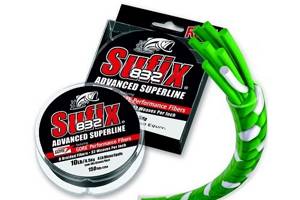
If a “nipple” or “elastic” tackle is used to catch crucian carp, then preference is given to braided fishing line
Which variety should I use?
So which one should you use? It is impossible to answer this question in monosyllables. After all, crucian carp is hunted in different ways. Therefore, the choice of fishing line for equipment will always be subject to: fishing conditions, size of the trophy, etc.
Network
Braid diameter:
- weight 200–300 g. - 0.07 mm;
- weight 300–700 g. — 0.09–0.1 mm;
- weight 700–1 kg and above – 0.1–0.13 mm.
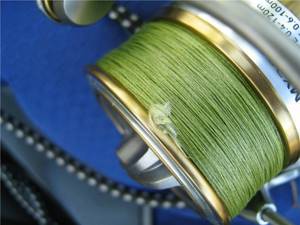
Monofilament
Monofilament diameter:
- fines - 0.12–0.14 mm;
- average - 0.16–0.2 mm;
- large - 0.25–0.28 mm.
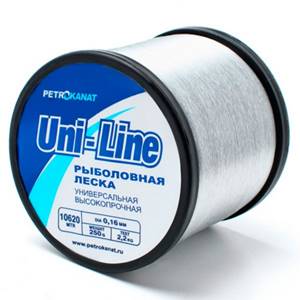
Fluorocarbon leashes for crucian carp
Recently, anglers have begun to actively use fluorocarbon for leader installation. Let us remember that this is a polymer made from fluorine and carbon compounds. Due to this, fluorocarbon leaders have a number of advantages over any fishing line:
- Invisibility in water (due to the low level of light refraction).
- Protection against mechanical abrasion and pulling (therefore, they are excellent for hard and sharp hooking, and also have a longer service life even in comparison with the highest quality braid).
- Resistant to high and low temperatures.
- A combination of good stretch and rigidity.
However, the “fashion” for fluorocarbon leashes is not entirely clear, because they also have several serious drawbacks. For example, a lower breaking load (almost two times) compared to high-quality monofilament fishing line of the same thickness.
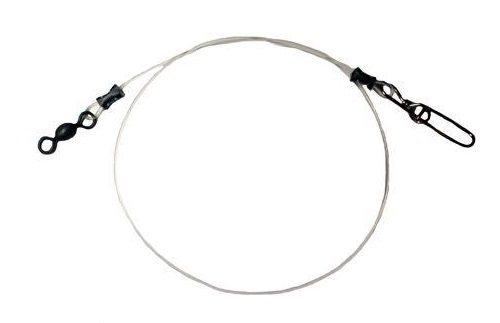
For fishing for crucian carp, you can use fluorocarbon leashes
Features of fishing for crucian carp and its habits
Navigation — Home → Hunting and fishing →In spring, crucian carp feed mainly on shallows, which warm up faster, and bite mainly in the morning hours, but not at dawn, but from about 9 to 12 o’clock. After that, the bite usually stops, depending on the reservoirs and their characteristics.
Large crucian carp, like small ones, go to shallow waters and shallow spaces; at this time, bottom and spinning tackle have their advantages.
But as the water warms up, the crucian carp begins to bite on the fishing rods.
In summer, it is easier to catch crucian carp with a float rod, since crucian carp actively takes both in shallows and in deep areas, and mainly feeds near the very shores, and there is no point in catching it with long rods and donks, here the most optimal float tackle is 3 meters long.
In autumn, crucian carp fishing is effective, both with short and long fishing rods, as well as with bottom tackle and spinning rods.
Float rod configured for catching crucian carp
To catch crucian carp, the fishing rod must be equipped with a fishing line as thin as possible, no more than 0.18, and preferably 0.12, a fishing line of this thickness is very soft and the crucian carp almost does not feel its resistance, and it is less noticeable to the crucian carp, a float is needed with a carrying capacity of 1.5- 2 grams, preferably one gram.
But with such a weight of sinkers, it’s problematic to cast the tackle, especially in windy conditions, you need to use size 5-7 hooks.
It’s better not to use smaller ones, since the percentage of fish coming off the hook is higher, and crucian carp throw larger hooks.
The tackle is usually equipped with two hooks on leashes of different lengths below the sinker, one 10 cm, the other 20 cm, this gives the fish some freedom when swallowing the bait, and crucian carp in most cases prefers to take the bait from the bottom.
Short gear of 3-4 meters is optimal for catching crucian carp, since the soft hooking speed is higher than that of long rods.
Donka (trick) for crucian carp
The donka is very effective for catching crucian carp.
Donka is a bottom tackle consisting of a supply of fishing line 50 meters long, no longer advisable, with a small sinker attached at the end of the fishing line, weighing 10-20 grams or more depending on the reservoir or casting distance, above the sinker at a distance of about 20 cm.
leashes with hooks about 10 cm long are attached, the number of leashes is optimally 3 pcs. Casting of the tackle is carried out: the fishing line is picked up in the place where the last leash from the sinker is attached, then the load is swayed and thrown to the intended place.
The main line is donkey 0.30, for leashes the line is 0.18-0.20
How to catch: after the tackle with the nozzle has been thrown into the water, pick up and tighten the line and hold it in your hand between the index and thumb, loosen the tension a little so that the line sag and wait for the bite, when you bite you will immediately feel the blows on the line, but don’t rush pull, wait for the fish to pull on the line and at that moment hook and pull out the fish.
The second option, which frees you from constantly holding the fishing line, is to stick a twig into the ground and hook the fishing line onto it, loosen it a little and hang the stick, this will be a nod, which will determine the bite, and when you pull the fishing line, you need to immediately hook and pull out the prey. With some experience, bottom fishing is much superior to spinning tackle, since holding the fishing line in your hand, almost all hooks are successful, and there are no cases when you are late for a bite.
Spinning tackle,
it is equipped in the same way as a donk, but the casting process is carried out with a spinning rod, the fishing line is selected further, the spinning rod is placed on the rod and a nod is hung to determine the bite, and also at the moment of tensioning the fishing line, a hook is made and the catch is pulled out.
RUBBER CARSP
In fact, an elastic band is the same donkey, it is a load weighing 0.5-3 kg, which is thrown or brought in by boat at a distance of 40-60 meters from the shore, depending on the length of the elastic band. A fishing elastic band is tied to this weight; its length without stretching should be slightly less than half the distance to the shore.
Next, a fishing line with a “battery” of hooks on leashes is attached to it through a carabiner or simply attached; there can be at least 10, at least 50 of them as desired. When a load with an elastic band is thrown, for example, at a distance of 40 m, the elastic band should be 18-20 m long without stretching .,with attached hooks.
Next, the elastic band is stretched by pulling out the fishing line with hooks, then the nozzle is placed on the hooks and the fishing line is slowly released.
The elastic band, compressing, pulls the hooks with the nozzle under the water to the fishing spot, when biting, the fish is hooked and pulled out, and after baiting, the fishing line is slowly released again so that the nozzle does not fly off, and the elastic band, compressing, delivers the nozzle to the fishing spot, this eliminates, as in spinning rods and donks, from constant casting gear, and the elastic band itself delivers the hooks to the fishing spot in the water (see figure). There are also many ways to catch crucian carp, but these are more difficult methods for an inexperienced fisherman. For example, when a crucian carp does not bite at all on any baits, it can be forced to peck only with a movable bait, that is, in the retrieve like a predatory fish, but with its own characteristics, the point is in twitching the baits and moving them, forcing the fish to grab the bait. This has its own tactics and it’s difficult to write about it, it all depends on the characteristics of the reservoirs, the flood of fish in a given reservoir, etc. And this is only for experienced fishermen with experience, these skills come on their own.
Return to the first part FISHING FOR CRUCCIAN, GEAR, FISHING METHODS
Source: https://otchelniki.e-veterok.ru/Ribalka_na_karasya2.html
Length of leashes when fishing for crucian carp
Having figured out which fishing line is best to use for leashes for this or that tackle, it is necessary to clarify one more point. This is their length. As a rule, it depends on the type of gear and fishing characteristics:
- Float rod – from 15 to 30 cm;
- Feeder, zakidushka or classic donka - from 20 to 80 cm;
- Makushatnik or “cork” – no more than 7 cm;
- “Elastic band” – from 10 to 30 cm.
Remember that short leashes have one serious disadvantage - the crucian carp feels the resistance of the tackle and often throws the bait only after trying it. Using leashes that are too long can have an even greater impact on the bite, and not for the better. The fact is that if the distance from the sinker to the hook is too large, then it is extremely difficult to notice the bite. In addition, you may not have time to hook a fish.
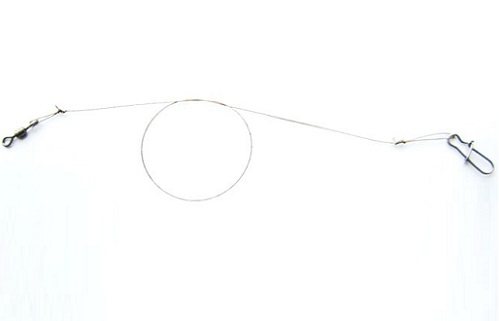
The length of the leash should be selected depending on the gear used
The angler’s task is to choose the optimal length for the leashes. This will increase the number of bites, reduce the number of trips, and increase the sensitivity of the gear.
Pay attention to the activity of the fish. Quite often, by installing longer leashes, the bite improves. Apparently, before this, the crucian carp was simply very cautious and refused the bait, feeling resistance from the float and sinker, or seeing the main fishing line. If there are a lot of bites and not all of them can be realized, then the reason may be the long length of the leashes. The crucian carp manages to either prick itself on the sting and throw the bait, or pull it off the hook. By reducing the length of the leashes, you can more quickly respond to the movements of the float.
Line thickness for leashes
The diameter of the lead line is another important parameter of any tackle for catching crucian carp. It is its thickness that largely influences the “courage” of the fish - whether it will actively try the bait or avoid it. After all, the crucian carp immediately sees a thick fishing line. This can be checked quite easily. If the bite is good, try changing the line on the leash to a thicker one. Believe me, a difference of just 0.02 mm will be enough to reduce the number of bites by almost half.
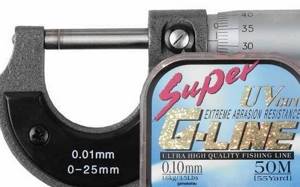
An important point when installing equipment is the choice of fishing line thickness
In general, the optimal thickness of the leader line should differ from the main line by 10-20% in a smaller direction. For example, the equipment of a float rod is monofilament with a cross-section of 0.14 mm. In this case, the fishing line for leashes should be no thicker than 0.12 mm.
At the same time, pay attention to such a parameter as tensile strength. When fishing for crucian carp, the lead line should not have a breaking load of more than 2 kg. The best option is the ability to withstand forces equal to 1.5-1.8 kg. Otherwise, the presentation of the bait will be unnatural, and the tackle itself will be heavy and too noticeable for the fish.
The breaking load of the fishing line for leashes should not be several times greater than the breaking or bending strength of the hooks. This negatively affects the sensitivity of the equipment.
If you fish with a feeder or some version of a donkey, then both the main and the leading line are always taken with a larger cross-section diameter than with float rods. But the requirements for habits remain. In any case, they should be thinner and more inconspicuous than the main line. Let us repeat that not only the invisibility of the equipment depends on this, thanks to which there are more bites, but also the ability to preserve the rest of the equipment when hooked, having lost only the hook.

The thickness of the fishing line is selected depending on the selected equipment for catching crucian carp
Fishing line for crucian carp: diameter, color, which line is best to use for fishing
In our regions, crucian carp is one of the most common types of fish, but it is worth considering that this fish is cunning, careful and picky. For the process of catching crucian carp to be successful, you need to choose the right fishing gear .
One of the most important elements of fishing equipment is fishing line. Below we will try to reveal all the rules for choosing this fishing attribute and describe its advantages.
Types of fishing line and their main parameters
Today there are several types of fishing threads for crucian carp:
- Monofilament is one cast nylon (polyethylene or made from other polymers) thread with high elasticity and rigidity. Under load, the thread stretches. This type of fishing line is available in any specialty store.
- Wicker. The main advantage is a high degree of strength. Braided fishing line consists of numerous thin threads that are intertwined using a special method; it practically does not stretch or deform.
- Fluorocarbon - high-tech materials are used in production. The fishing line has a low refractive index of light, it is invisible in water, has high elasticity, but does not bend or deform. But there is also a minus - it is designed for light loads.
Line diameter
When selecting a fishing line, you need to understand that the number of bites will directly depend on its thickness . For thin line you need to use light weights on the rig. In water, a thin fishing line is less noticeable to fish.
Important: the thinner the fishing line in diameter, the less windage it has in the water. This factor is important to consider in the presence of currents or strong winds.
When fishing for crucian carp, it is recommended to use a thread with a diameter of 0.1 to 0.14 mm , from a reliable manufacturer. For crucian carp (since it is a sensitive fish), it is recommended to choose either braided or mono.
Line color
Crucian carp are capable of distinguishing colors, therefore, it is recommended to carefully choose the color of the fishing line. Most often, gray or brown color is chosen (if there is a large amount of silt in the reservoir). If the pond is transparent, a colorless thread is recommended.
Line stretchability
This parameter shows how much the thread can increase in size without breaking. For bottom gear, stretchability is very important, since the bite is determined directly by the rod nod, and if the stretchability indicators are high, then the moment of biting will be extremely difficult to determine.
What line to use for catching crucian carp
It is important to correctly decide on the type of fishing line for catching crucian carp, let's study this issue in more detail.
Thickness and color of fishing line for crucian carp
For rods with floats, it is recommended to use braided thread with a diameter of 0.1 mm or mono with a diameter of 0.2 mm. For the donkey, it is recommended to select a braided thread with a cross-section of 0.15 mm and for a leash with a cross-section diameter of 0.1 mm, or select a monofilament main thread with a cross-section of 0.3 mm and for a leash with a cross-section of 0.2 mm.
The color in this case is also very important, since the fishing line should not scare away the fish.
Tip: for clear water, a colorless thread is recommended, for a reservoir with a green tint of water and a lot of vegetation - green, for a reservoir with muddy and dark water - brown or gray.
Monoline or braid: which is better?
Which thread to choose for fishing for crucian carp - mono or braided? It's simple. If you are using a feeder, it is better to use braid, and for float rods, monofilament would be the ideal option.
Line for catching crucian carp with a feeder
Let's take a closer look at the rules for selecting fishing line for long-casting rods. A thicker line for the feeder is recommended. If you take monofilament, then its diameter is selected from 0.18 to 0.3 mm, and if braided, then the cross-sectional diameter should be from 0.12 to 0.14 mm.
When selecting a fishing line, you need to take into account the fishing characteristics. For the longest casts, it is recommended to use braid, as the bite will be felt easier.
But at distances up to fifty meters it is better to give preference to monofilament. Also, the selection of fishing line should be influenced by the reservoir itself, its latheriness and the amount of algae.
The elasticity of the fishing line is selected taking into account the presence of obstacles in the reservoir.
Fishing line for catching crucian carp on a float rod
Among the features of selecting tackle for fishing rods with floats it is worth noting:
- fishing is usually done near the shore, where the fish are smaller (maximum 300 g);
- in this embodiment, the bias is placed on the float, therefore, you should not pay special attention to the stretchability of the fishing line;
- the use of monofilament is allowed;
- The cross-section of the fishing line for crucian carp fishing should be a maximum of 0.16 mm.
The correct leash for crucian carp
Each rig has a leash - a fairly important part of it. Installing leashes on crucian carp is not always easy and simple, since during installation you need to know their exact length, combination with the type of fishing line, fastening methods, etc.
Why do you need a leash when fishing for crucian carp?
A leash during crucian carp fishing is necessary to perform a number of functions:
- make the fishing line more invisible;
- in the presence of a blind hook or in the event of a large bite, it allows you to save both the sinkers and the float;
- helps lures and bait look as natural as possible in the water.
Leash length
After the type of fishing line used is determined, the length of the leash is selected:
- for a float rod - from fifteen to thirty centimeters;
- for elastic - from ten to thirty centimeters;
- for the crown - no more than seven centimeters;
- for the feeder - from twenty to eighty centimeters.
It is important to remember: short leashes increase the resistance of the gear, and the crucian carp can throw the bait. Using the longest possible leashes can also adversely affect the quality of the bite.
Leashes in the “spring” and “top” rigs
“Spring” is a well-known method of catching crucian carp; it uses a feeder (spring) with many hooks on which foam balls are placed. There is complementary food in the feeder.
The fish gradually releases all the hooks and mistakenly sucks them in.
For this type of fishing, a fishing line (main) with a diameter of 0.25 to 0.40 mm is used, and for leashes it is recommended to use braid with a diameter of 0.04 to 0.10 mm.
The “makushatnik” is made like a spring, but both the bait and the groundbait are in one piece. For this type of gear, a main thread with a diameter of 0.35 mm is used, and for leashes a braid with a diameter of 0.18 mm is used.
How to knit leashes and hooks for catching crucian carp
Let's consider an example on a fishing line with a length of one hundred and twenty centimeters. At the end you need to make a loop about eleven centimeters, and on the loop - a double, well-tightened knot. You need to pass the loop through the special holes on the weights twice. Pull the opposite edge of the fishing line into the resulting eyelet and tighten it carefully.
Now let's move on to the hooks and leash. We take three hooks and fishing line for the leash. We attach the hook to five turns of fishing line and make a strong knot on the hook. Gradually you need to attach all the hooks to the leashes. Determine the length of the leash. Using a figure eight knot, we attach the leash to the main line. Thus, there will be three leashes with hooks on the fishing line.
You can watch a video on the Internet to make the process clearer.
Manufacturers of fishing lines and model range (review)
Today there is a wide range of manufacturers and models of fishing lines on the market. In addition to the huge assortment of Chinese brands, which improve the quality of their products every year, in special stores you can find fishing lines and other well-known brands. The most popular manufacturers who have managed to establish themselves on the positive side are:
- 3M Company, DuPont - America;
- Bayer - Germany;
- Kureha Chemical Industries, Yotsuami, Morris, Sunline, Toray, Sanyo, Duel - Japan.
All products from these manufacturers have high quality indicators, wear resistance and decent shelf life. All cords from these manufacturers are durable and soft.
Of the most popular brands of fishing line for crucian carp, it is worth noting:
- Mitsubishi-Robinson-Titan Power;
- Sumo;
- Tectan;
- Power Pro;
- Steel Power;
- Fireline.
When choosing threads for fishing rods for crucian carp, you need to carefully read the annotation, since the name of the fishing line brand may not coincide with the name of the manufacturer.
Conclusion
During the preparation period for fishing for crucian carp, it is important to carefully prepare, choose the right type of fishing line, its diameter, color, and carefully prepare the tackle with leashes . By combining all the nuances, fishing will be one hundred percent successful and will allow you to get a decent catch.
Source: https://onfishing.club/ryby/mirnaya/karas/leska-na-kar.html
Length of leashes for feeder fishing for crucian carp
The most difficult thing is to choose leashes for catching crucian carp on a feeder. We have already noted above that their length can vary from 20 to 80 cm. Moreover, some fishermen use longer leash structures (about 1 m) on the English donka. Therefore, the logical question becomes: “How do you understand what length of fishing line should be on the leashes on the feeder?”
Many will say that the larger it is, the better. But that's not true. The leashes on the feeder simply do not have the correct length. The fact is that it depends on many factors:
- places on a body of water;
- bottom features;
- season;
- water and air temperatures;
- weather conditions;
- current forces;
- sensitivity of gear and rod;
- habits and preferences of the fish itself.
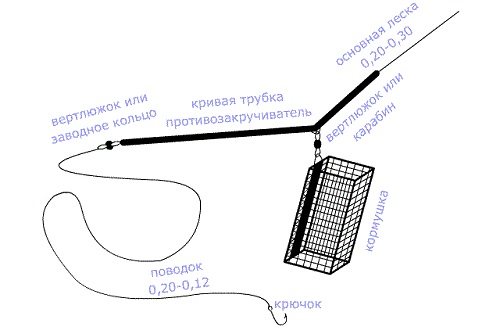
When choosing the length of the feeder leads, a number of features should be taken into account
This list could go on for quite a long time. Therefore, experienced fishermen, coming to a reservoir, constantly experiment with the length of leashes. Otherwise, catching crucian carp on a feeder, especially large ones, can sometimes be difficult. However, by choosing the optimal length of fishing line from the feeder to the hooks with nozzle, you can count on a good catch.
Of course, usually leashes are placed on the feeder, the length of which is about 40 cm. Most often, this is enough to place the bait not close to the feeder, but so that it is in the field of view of the crucian carp attracted by the bait. But it also happens that fish only bite on feeder equipment with short (about 20 cm) or, conversely, long (about 80-100 cm) leashes. So anglers have to constantly try different options.
Fishing for crucian carp. How not to miss the desired trophy. It's all in the line
Crucian carp are the most unpretentious fish to their living conditions. Their preference is for bodies of water with stagnant water and a muddy bottom where algae occur. In addition, these fish are very hardy - crucian carp can live for quite a long time in reservoirs with a low oxygen content or even in the remains of silt on a dry pond.
At the same time, crucian carp are very careful, so to catch them you should carefully select equipment.
Spring will be characterized by a good bite - crucian carp are hungry at this time of year and are able to attack any of the baits.
With the onset of summer, it is most effective to catch crucian carp in the depths, in pits. At about eight o'clock in the morning their appetite awakens, and they actively swim to the aroma of groundbaits made from porridge or dough.
Correctly chosen equipment is the key to success when fishing for crucian carp
With the arrival of autumn, crucian carp should be kept on guard on ledges from the pits. As the weather gets colder, they wake up later, around 11 am, and will delight you with bites only in good weather. When fishing, the crucian carp desperately resists, and it depends on the fishing line chosen by the fisherman whether he can hook it and pull it out.
Choosing equipment for different types of crucian carp fishing
To enjoy the reward in the form of solid crucian carp, the equipment must be prepared quite carefully. You should pay close attention to each of its elements. Let's take a closer look at what you should pay attention to when fishing for crucian carp.
This equipment is chosen by many anglers. In this case, a piece of poppy seed serves as groundbait, bait and feeder. The main fishing line is used, the thickness of which is 0.35 mm; for leashes, 0.18 mm braid is more suitable.
"Spring" or "foam fishing"
Leashes with hooks and mounted with foam balls are attached to a wire feeder, similar to a spring. You need to fill the feeder itself, along with the hooks, with complementary foods.
After the crucian carp has absorbed the bait, the hooks will be released and, thanks to the buoyancy of the foam, will rise above the bottom. The crucian carp will reflexively swallow them.
For this equipment, a fishing line with a thickness of 0.25-0.40 mm as the main one, and for leashes a braided line from 0.04 to 0.10 mm, is more suitable than others.
Float equipment
This type of equipment is most popular among anglers when fishing for crucian carp. It is light and does not scare away the fish. A telescopic rod with the necessary flexibility and length is ideal.
You can also use a bamboo three-knee, which has a durable and flexible third knee.
It is recommended to equip it with a braided fishing line of 0.10-0.15 mm as the main one, and a leash made of durable fluorocarbon with a thickness of 0.12 mm.
Feeder
The feeder has particularly sensitive equipment. When fishing for crucian carp, symmetrical and asymmetrical loops are used.
In muddy and overgrown areas, you should use a paternoster - easy to manufacture, but at the same time quite effective feeder equipment with maximum sensitivity.
As the main one for this equipment, you should use a braid of 0.1-0.12 mm, for leashes - a monoline with a slightly larger diameter - 0.14-0.16 mm.
An enviable catch won't take long to arrive
Leashes
The length of the leashes is chosen by each angler based on his preferences. Typically for the described gear it is:
- from 5 to 7 cm – for the “top” and “spring”;
- about 1 m – for the feeder;
- approximately 15 cm - for a float rod.
It is also necessary to take into account the characteristics of bites. The more active they are, the shorter the leash should be. If the bites are cautious and rare, the leash should be longer. Ideally, you should have a certain assortment of leashes with you, so that if necessary, you can make quick replacements.
A significant role in the choice of fishing line is played by its price aspect - monofilament costs less than braid and fluorocarbon. Experienced fishermen prefer fishing line from Japanese manufacturers; their products have the best price/quality ratio. There is no need to save on fishing line, because the quality of this element of equipment determines how effective the entire fishing will be.
Knowledge of the way of life of crucian carp, the ability to detect their place of concentration and the use of suitable equipment is the key to enviable catches.
Source: https://master-fisher.ru/2017/05/17/lovlya-karasya-kak-ne-upustit-zhelannyj-trofej-vse-delo-v-leske/
Useful tips
- It is best to have several leash options with you on every fishing trip, which will differ in the length and thickness of the fishing line. To quickly replace them, you can use a system of fishing swivels and fasteners.
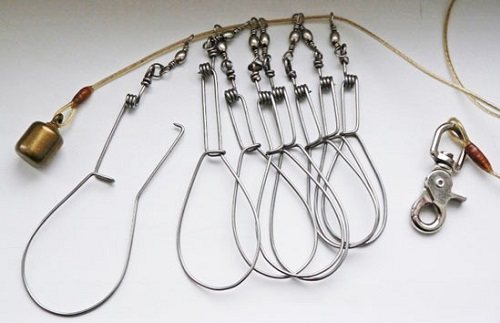
Having several leads in stock increases your chance of a good catch.
- When purchasing fishing line for leashes, remember that 90% of manufacturers deliberately underestimate its actual thickness by about 0.01–0.03 mm. Thus, it is possible to make “super-strong” fishing lines, which, with a small cross-section, show an excellent breaking load. Therefore, feel free to add another 5-10% to the information on the thickness of the monofilament indicated on the package.
- Never skimp on the leader line. It must be of the highest quality and most reliable, which is only available for sale. Moreover, its consumption is much less than that of the main fishing line. Therefore, when buying a reel of material 100-150 m long for leash installation, it will last you more than one year.
- We must not forget about the high-quality attachment of leashes to the main fishing line. After all, up to 40% of the strength is lost on a bad knot. It turns out that a palm-sized crucian carp, while offering decent resistance, can easily break off a poorly mounted leash. This will obviously upset the fisherman and, most likely, will be disastrous for the fish itself, in whose mouth the hook and line will remain.
From the video you will learn how to knit leashes for fishing:

